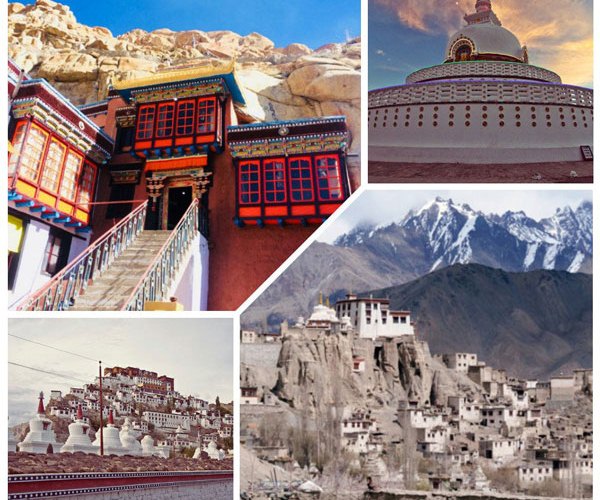
Thiksey Monastery
Thiksey monastery is located on a hilltop, 21 km east of Leh. Je Tsongkhapa, the founder of the Gelug School, sent six of his disciples to spread the teachings of the new school. Tsongkhapa gave Jangsam Sherab Sangpo, a small statue and instructed him to meet the King of Ladakh to seek his help in the propagation of Buddhism. The King loved the gift of the statue. He directed his minister to help Sherab Sangpo to establish a monastery of the Gelug order in Ladakh. Thiksey Monastery consists of four main buildings; they are the assembly hall in yellow building, guardian deity shrine in red building, Tara temple and Maitreya temple.
Shanti Stupa
Shanti Stupa stands peacefully and beautifully on a hilltop in a place called Changspa in Leh. It is a white-domed Buddhist Stupa built by the Japanese and Ladakh Buddhists. It was built to encourage and promote world peace and prosperity. If you choose the staircase to reach Shanti Stupa instead of the road, not only would it be fun but also a satisfying adventure. Shanti Stupa looks beautiful and serene in all four seasons, and especially when it snows. You can have a look at the picturesque view of the Leh market, Changspa village and surrounding areas from the Stupa. It is definitely a niche for photographers.
Spituk Monastery
Spituk Monastery is situated 7 km to southwest of Leh and it was founded by Od-de, in the 11th century AD; when the monastic community was introduced. Lotsava Rinchen Zangpo (the great translator) visited this monastery and named the monastery “Spituk” meaning exemplary. In those days the Gonpa belonged to the Kadampa School but Gelukpa order was introduced during the reign of King Dragspa Bum-Lde, when Lama Lhawang Lotus restored the monastery. "Spituk Gustor Festival" takes place in the courtyard of the monastery, on the 18th and 19th of the 11th month of Tibetan Calendar.
Stok Monastery
Stok monastery is situated 14 kms southeast of Leh and it was built by the Lama Lhawang Lotus in the 14th century. It has all of the 108 volumes that are part of the teachings of Buddha called Kangyur. King Tsespal Tondup Namgyal built Stok palace & Museum in the year 1825, after Zorawar Singh's annexation of Ladakh. Gurphuk Gonpa, a branch of Spituk Monastery is a little away from the palace, which is famous for its festival "Guru Tsechu" held on the 9th and 10th of the 1st month of Tibetan Calendar.
Matho Monastery
Matho Monastery is situated 26 km south east of Leh. It belongs to the Sakya Order and it was founded in 1410 century by Lama Dugpa Dorje. Matho monastery has a collection of thangkas dating back to the 14th century. Matho monastery is popular for Matho Nagrang Festival. During this two-day festival, mask dances are performed by monks of the monastery wearing colorful silk brocade robes and masks. Two oracles appear in the courtyard of the monastery accompanying the mask dancers.
Hemis Monastery
Hemis Monastery is around 45 kms south of Leh and it belongs to the Drukpa order. The monastery was founded by the first incarnation Stagsang Raspa Nawang Gyatso in 1630, who was invited to Ladakh by a king Singey Namgail, and offered him a religious estate throughout the region. The youngest son, Nawang Namgail, became a monk and his name was changed to Zamling Drags. The Monastery was named Changchub Samling and the community was introduced. The Hemis festival is held in the month of June.
Alchi Choskhor
Alchi Choskor is widely believed as the very first Buddhist temple in Leh Ladakh located nearly seventy kilometers away from Leh towards Srinagar. Lostawa (translator) Rinchen Sangpo founded Alchi Choskor in reviving Tibetan Buddhism. It is the only monastery that has preserved 10th century Buddhism arts and crafts. The fundamental reason of Alchi Choskor survival is that Alchi Choskhor is enclosed by mud-brick wall and looks simple that it is hardly distinguishable from the ordinary houses of Alchi village. Because of its exterior humble appearance, Alchi escaped attention of invaders from neighboring regions that desecrated and plundered monasteries that were located on the Leh-Srinagar trade route.
Likir monastery
Likir monastery is situated in Likir village and the village got its name from the monastery Klu-Khil meaning ‘the Naga Encircled’-a myth associated with the founding of this monastery. It is 53 kilometers west of Leh and was founded in 1065 A.D. by Lama Duwang Chosjey during the reign of King Lhachen Gyalpo. The annual monastic festival “Likir Dosmochey” takes place on the 28th and 29th day of the 12th month of Tibetan calendar. The monastery has two assembly halls, known as Dukhangs and the older one is located on the right of the central courtyard with six rows of seats for the lamas and a throne for the Head Lama of Likir.
Lamayuru Monastery
The Lamayuru “Yungdrung Tharpaling Gonpa” is remarkably built on natural pillar-like formations of sandstone. It lies around 125 kilometers west of Leh on the Leh-Srinagar highway. Lamayuru belongs to the Drikungpa order of Tibetan Buddhism. The great translator Rinchen Zangpo constructed a temple here in the 11th century. Naropa also visited Lamayuru, which was taken care of by Kadampa School of Tibetan Buddhism, but later it was taken over by the Drikingpa order. This monastery also have a festival called ‘Yuru Kabgyat’ which takes place on 17th and 18th day of the 5th month of the Tibetan calendar.
Takthok monastery
The Takthok monastery is located 50km east of Leh. The monastery came into existence when Guru Padma Sambhava visited this place and blessed it in the 8th century. The monastery was merely a meditation cave of Padma Sambhava, with footprints and many other signs, until the reign of King Tsewang Namgail. When Mahasiddha Kunga Phunstog introduced monastic community, it was given the name of Takthok Padmalinggon. The Takthok Festival is held in the month of July or August.